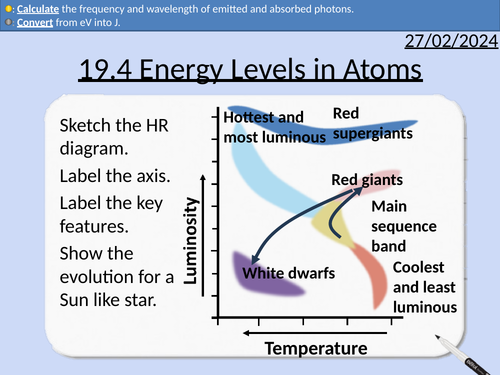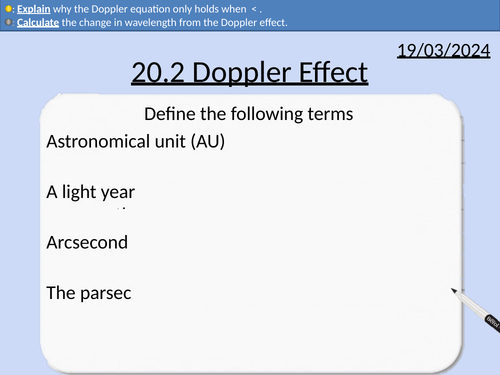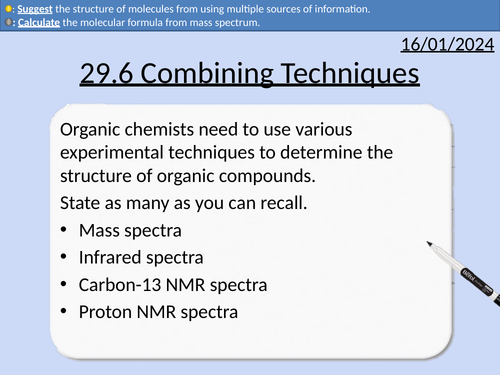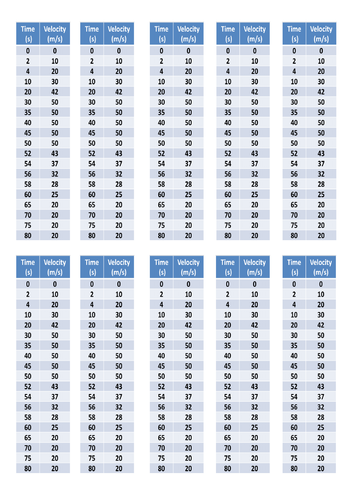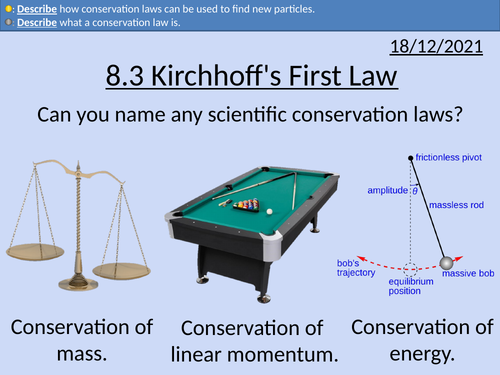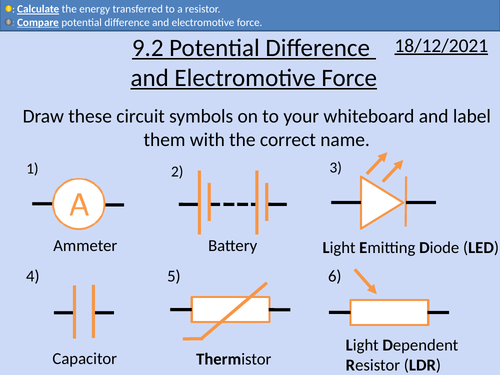496Uploads
164k+Views
70k+Downloads
All resources

A level Chemistry: Interpreting Proton NMR Spectra
OCR A level Chemistry: 29.5 Interpreting Proton NMR Spectra
This PowerPoint is a whole lesson included with student activities, animated answers, homework questions with answers provided.
This lesson covers:
Predicting proton NMR spectra for molecules
Identifying the number of different proton environments
Identifying the types of proton environment and chemical shifts
Integration traces (area of peaks) and relative number of protons
The spin-spin splitting pattern (n + 1)

OCR A level Physics: Energy Levels in Atoms
OCR A level Physics: 19.4 Energy Levels in Atoms
Module 5 Newtonian World and Astrophysics
This PowerPoint is a whole lesson included with student activities, animated answers, homework questions with answers provided.
This lesson covers:
Atoms have different electron arrangements
Ground state energy
Bound electron states being negative
Converting between joules and electronvolts
Calculating the change of energy between energy states
Calculating a photon’s frequency and wavelength

OCR A level Physics: The Doppler Effect
OCR A level Physics: 20.2 The Doppler Effect
Module 5 Newtonian World and Astrophysics
This PowerPoint is a whole lesson included with student activities, animated answers, homework questions with answers provided.
This lesson covers:
The definition of the Doppler effect
Changes in pitch of sound waves due to relative motion
Absorption spectra and electron energy levels
Red-shift and blue-shift absorption spectra
The Doppler equation
The condition for velocity for the Doppler equation

OCR A level Physics: Astronomical Distances
OCR A level Physics: 20.1 Astronomical Distances
Module 5 Newtonian World and Astrophysics
This PowerPoint is a whole lesson included with student activities, animated answers, homework questions with answers provided.
This lesson covers:
Astronomical distances: light-years, parsec, astronomical unit
Astronomical angles - degree, arcminute, arcsecond
Parallax Angle

OCR Applied Science: 6.1 Mechanical Properties of Materials
This PowerPoint presentation with worked examples and student activities covers:
Topic 6.1 of Module 1: Science Fundamentals of the OCR Applied Science Spec.
• Interpreting laboratory tests for stress-strain graphs and Young’s modulus
• Awareness that repeated loading cycles may cause failure by fatigue below the yield strength
• Use of diagrams to understand that the way molecules are arranged in polymers determines the properties: chain length, crosslinking, use of plasticizers and crystallinity.
• Use and rearranging of the density equation.

GCSE Biology: Carbohydrates, Proteins, and Lipids
This presentation covers OCR Gateway Biology 9-1 B1.3.1 Carbohydrates, Proteins, and Lipids
This PowerPoint is a whole lessons included with student activities and animated answers.
The three main macronutrients - carbohydrates, proteins, and lipids
Names of enzymes - carbohydrase, amylase, protease, lipase
What the macronutrients are broken down into - simple sugars, amino acids, fatty acids and glycerol.
Metabolic rate
Food tests and the positive results

OCR A Level Physics: Satellites
OCR A level Physics: 18.5 Satellites
Module 5 Newtonian World and Astrophysics
This PowerPoint is a whole lesson included with student activities, animated answers, homework questions with answers provided.
This lesson covers:
Key features of geostationary and low polar orbit satellites
Conditions for stable orbits for satellites
Applying Kepler’s laws to the orbits of satellites

A level Chemistry: Combined Techniques
OCR A level Chemistry: 29.6 Combined Techniques
This PowerPoint is a whole lesson included with student activities, animated answers, homework questions with answers provided.
This lesson covers:
Percentage yield to determine empirical formula
Mass spectra
Infrared spectra
Carbon-13 NMR spectra
Proton NMR spectra

OCR AS Physics: Intensity
OCR AS Physics A: Intensity is a part of the Module 4: Electrons, Waves, and Photons. PowerPoint with worked examples and homework.

OCR AS Physics: Refractive Index
OCR AS Physics: Refractive Index is a part of the Module 4: Electrons, Waves, and Photons. PowerPoint with worked examples and homework.

GCSE Physics: Electrical Power
This presentation covers OCR Gateway Physics 9-1 P3.2.8 Electrical Power.
Definition of power
Standard form for kW and MW
The three equations for power
Rearranging electrical power equations
Derivation of P = I^2 R with subsitution
Students questions and worked solutions

GCSE Physics: Atmospheric Pressure
This presentation covers OCR Gateway Physics 9-1 P1.3.3 Atmospheric Pressure
This presentation includes:
Balanced and unbalanced forces
Resultant force
Changing atmospheric pressure
Exam style question with mark scheme

GCSE Physics: Every Day Forces
This presentation covers OCR Gateway Physics 9-1 P2.2.5
Presentation comes with worked examples, student questions and answers.
Newton’s first Law
Terminal velocity
Free body diagrams
Plotting data
Determining acceleration for a velocity-time graph
Determining distance traveled for a velocity-time graph

GCSE Physics: Springs and Energy
This presentation covers OCR Gateway Physics 9-1 P2.3.2
• Spring Energy Equation
• Rearranging equation with two methods
• Problems and worked solutions
• Exam style question and answer
• Analysing force-extension graphs

OCR A Level Physics: Simple Harmonic Motion and Energy
OCR A Level Physics: Energy and Simple Harmonic Motion presentation with homework and answers

OCR AS level Physics: Kirchhoff's First Law
OCR AS level Physics: Kirchhoff’s First Law is a part of the Module 4: Electrons, Waves, and Photons.
Presentation come with worked examples, solutions and homeworks
Apply Kirchhoff’s First Law
Kirchhoff’s First Law in mathematical form
Kirchhoff’s First Law in written form
Describing conservation laws
Women in Science - Emmy Noether
CERN and jobs in physics

OCR AS level Physics: Current and Charge
OCR AS level Physics: Current and Charge is a part of the Module 4: Electrons, Waves, and Photons.
Presentation come with worked examples, solutions and homeworks.

OCR AS level Physics: Potential Difference and Electromotive Force
OCR AS level Physics: Potential Difference and Electromotive Force is a part of the Module 4: Electrons, Waves, and Photons.
Presentation come with worked examples, solutions and homeworks.
Calculating the base SI units for volts
Comparing potential difference and electromotive force (emf).
Circuit diagrams for measuring potential difference and emf.
Calculating energy dissipated in a circuit.

OCR AS level Physics: Derived Units
OCR AS level Physics: Derived Units is a part of the Module 2: Foundations of Physics
Full lesson PowerPoint with worked examples and homework with complete worked answers.
Indices Notation
Converting from Celsius to Kelvin.
Determining base units from derived units.

OCR AS level Physics: Stopping Distances
OCR AS level Physics: Stopping Distances is a part of the Module 3: Forces and Motion
Presentation come with worked examples, solutions and homeworks.


